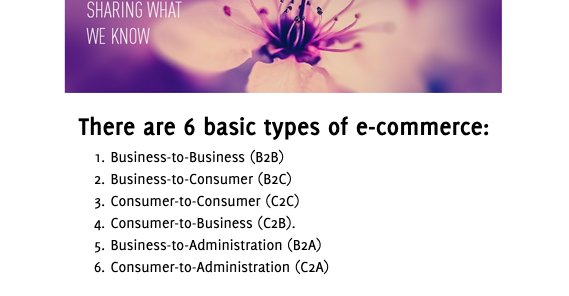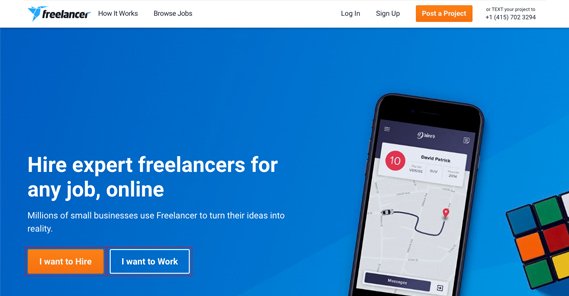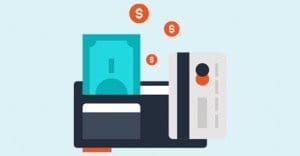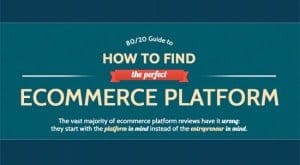The Exhaustive List of Ecommerce Types and Categories
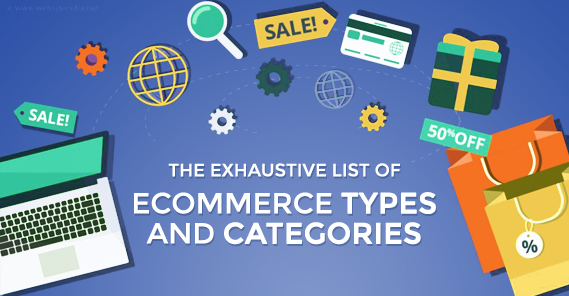
If you’re interested in starting up a web business, it’s important to have a good idea of what business you might start. What kind of ecommerce category do you fall into? There are important considerations for each different type, and those considerations can vary quite a bit. For example, if you’re looking to sell a service, you need to establish yourself as enough of an authority that people will trust you. If you’re selling something in a retail format, you need to figure out your inventory and fulfillment processes. Let’s explore, shall we?
B2C Vs B2B Vs C2C Vs C2B
First, let’s cover the broad, top-level ecommerce categories. I figure there are only four of them, but some people think there are as many as six; more on those in a moment. The main four are those I’ve listed in the subhead. So what are they, if you’re not familiar with the acronyms?
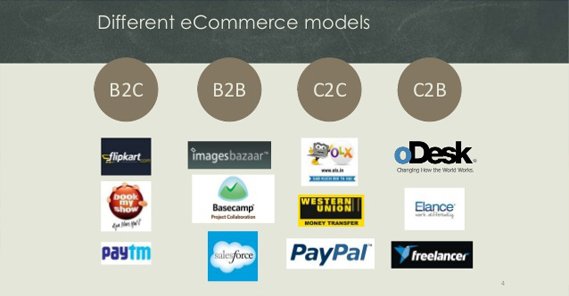
Business to Consumer is the most traditional type of business you think of when you think about, well, a business. A retail store is a business to consumer brand. Amazon is large business to consumer. A store like Office Depot is a hybrid, catering to home users and to businesses. Business to consumer brands are businesses that sell products directly to non-business customers.
Business to Business brands are also very common. Think about any service provider with a business tool to sell you. Google has a lot of business to business tools. Marketing platforms like Hubspot or MailChimp or HootSuite are all business to business companies. A business to business brand is simply a brand that is selling their services to other businesses, either of a specified scale or of any scale with varying pricing and service levels.
Consumer to Business is a less common type of transaction, but it has become increasingly common over the years as the benefits of hiring an employee drop, while the benefits of contracting a freelancer rise. A freelance writer working for a company is a C2B relationship. A website that provides stock photos is acting as a middleman; consumers produce the content and businesses can buy it.
Consumer to Consumer is the newest and fastest growing form of transaction. There are a variety of different ways this can manifest, from traditional to brand new. Traditional consumer to consumer transactions include small-scale sales like a yard sale or the transactions facilitated by eBay or Craigslist. It also includes the entire gig economy, ranging from for-contract courier services to Uber.
Some people also consider B2G or B2A as different from B2B. The G or the A stand for Government or Administration. Selling a service to the government as a contractor would be a B2G transaction. Filing and handling tax services would be a B2A service, potentially. I figure these are just a sub-set of B2B, if you consider the government or various public administrations to be a variety of business, or at least an organization. It’s not strictly necessary or beneficial to make the distinction.
So, the first thing you need to decide when you’re starting a business is what your target audience will be. Are you going to be a freelancer selling your services to companies? Are you a creative, working with whoever will pay you? Are you going to set up a deal with manufacturers or retailers to sell for them or refer customers? You have quite a few options.
The second thing you need to do is pick a business model. Here are three divisions, and the business models you might find within.
Tangible Goods
The first category of ecommerce is the traditional retail sales model, and various related business models. I call it the tangible goods category, because what you would be providing to your customers is a tangible product, something that can be handled physically and requires shipping.
Retail Sales, also known as Wholesaling and Warehousing, is the traditional sort of sales model. You produce, or hire someone to produce for you, physical products. You then store those products somewhere, be it in your spare bedroom or in a warehouse down by the docks. You create a website with a catalog users can use to browse your products, or you use a third party system like Amazon or Etsy to showcase your inventory. Customers make an order, and you fulfill the order, handling all of the shipping and support. Some companies, like Amazon, offer services like Fulfilled By Amazon to ease some of this process and guarantee shipping.
Retail sales can range from B2C, where you’re a company selling items to people, to B2B, where you’re wholesaling large quantities of products to other retailers, who will sell at a markup. Either way, you’re the initial provider of the item, not counting whatever factories you have hired to produce it for you.
Drop Shipping is a way to streamline the retail sales model. A wholesaler doesn’t care about most small customers; it’s not worth their time selling individual cans of Coke to people when they can sell truckloads to retailers instead. A drop shipper steps in and says “I will make you a deal; I will aggregate orders from small customers and process them; all you need to do is ship to the addresses I supply.”
There are a ton of drop shippers on Amazon. It’s incredibly easy to set up contracts with certain wholesalers and list products on Amazon (or your own storefront, set up using Shopify and some plugins), and sell those products. Customers are buying at a markup – so you can profit – but they don’t care, or the wholesale price isn’t available to them, and so on.
White Labeling is sort of like a form of drop shipping, or of wholesaling, as a kind of bridge in the gap between them. You typically purchase products from a company and sell them to individuals, like you would with drop shipping. However, instead of keeping the manufacturer or wholesaler’s branding, you add on your own branding. This is common in the health and beauty niche, but is more difficult in other niches.
Print on Demand is somewhat similar to drop shipping, though you can be the first-party provider or a second-party middleman depending on your position. You can do the printing yourself, or you can hire a printing company to print what you want them to. The difference between print on demand and drop shipping is simply that, with wholesaling and drop shipping, there’s a warehouse full of products somewhere just waiting to go out. With print on demand, the item is not created until an order comes in. This is exceedingly common with apparel and small accessories like phone cases. It’s also common with art prints.
Affiliate Marketing is similar to drop shipping, except you’re not handling any part of the process except advertising. With drop shipping, you have to create the storefront, and forward orders on to your wholesaler. With affiliate marketing, you don’t even handle orders; you simply direct customers to your wholesaler’s storefront. Amazon also does this; the Amazon affiliate program allows anyone to just make a link that points to a listing on their storefront, where they get paid if their referred user makes a purchase. It has the lowest overhead – all you need to succeed is a blog – but it’s also likely to have slimmer profit margins.
Manufacturing can be considered the root of all B2B tangible goods sales. Being the company that actually creates the products means you can make a lot of profit; if a widget you sell costs $100 per case, and it takes you $2 worth of materials to manufacture the case, you’re pulling in a lot of cash. The trick is, you have to source raw materials and you need the hardware to manufacture the products in bulk at a rapid pace. There’s a reason most manufacturing is now performed in places like China; it’s expensive to get set up and reconfigured.
Many of these ecommerce categories have a supplemental or spin-off type in the form of subscription services. The Dollar Shave Club is a prime example; they’re a drop shipping and white labeling company that operates on a subscription model rather than discrete sales. For the most part, I don’t consider these subscription services to be different categories; they’re just recurring orders for existing categories.
Intangible Goods
There is a lot of overlap between tangible goods and intangible goods sales. Many of the same business models apply. Affiliate marketing, for example, works equally well for Amazon regardless of whether you’re buying a book or an ebook.
Digital Product Sales are a form of intangible good where you’re simply selling something that has no physical form. Software is the prime example; everything from boxed software at Best Buy to the library you can buy on Steam can count as digital product sales.
Training Courses are another form of intangible good. It’s different from a service, because you aren’t necessarily training anyone directly; rather, you’re providing video lessons and coursework in PDF form, and whatever else is included.
Services
The final ecommerce type is being a service provider. Rather than providing a book, you provide the service of writing. Rather than providing a painting, you provide the service of graphic design.
Freelancing is one of the primary forms of service one can provide online. Freelancers can do anything from coding and writing to art to marketing. Almost anything a business needs can be done by freelancers, though it’s not always appropriate to contract freelancers rather than hire employees. There’s also the middleman business model of providing connections; sites like Upwork or WriterAccess provide the service of connecting freelancers with people who want to hire them.
Consulting is another form of service one can provide. You don’t have to provide the service for a company directly, but you can examine their processes and explain to them how they can improve, with your own recommendations, and perhaps your own services on offer. Consulting is simple outsourcing institutional and industry knowledge.
Training is similar to consulting, but more in-depth. You can hire someone to train yourself or your employees in a task. Training is often provided along with tangible and intangible goods as well.
As A Service (XaaS) is an entire class of internet-based service providers. Anything you think of as a web app today is usually “software as a service”. Rather than buying a piece of software and the hardware to run it, you buy access to someone else’s computer running that software. Anything from Google Analytics to Canva to Microsoft’s Office 365 can be an example of software as a service.
More than just software can be provided as a service. Amazon’s web services, Google’s App Engine, and WordPress.com hosted blogs are examples of Platforms as a Service. Content Delivery Networks and outsourced processing power in the Google Compute Engine are examples of infrastructure as a service.
Any as-a-service model relies on uninterrupted internet connections and reliable providers to succeed, which is why many of them tend to be B2B; they need the scale to support themselves. Still, more and more, these are becoming commonplace.
Once you have chosen your target audience and the category for your ecommerce business, you can start to nail down more of the details. What is your product or service?
How are you going to provide it? What kind of infrastructure do you need in place to succeed? Have at it, and good luck!
 ContentPowered.com
ContentPowered.com
